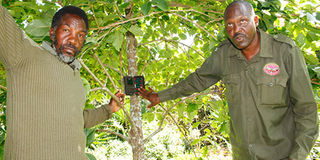Ex-game hunter moves to save rare mountain bongo

Bongo trackers Josphat Korage (right) and Boniface Nderitu demonstrate how they set up camera traps that help in establishing the mountain Bongo populations and locations in the Aberdares, Mt Kenya and Mau Eburu forests. PHOTO | DAVID MUCHUI | NATION MEDIA GROUP
What you need to know:
- The mountain bongo has also vanished from the northern Aberdare sector where two individuals were living.
- Being a highly elusive antelope that lives in dense forests and rugged terrain, it has also been difficult to monitor its behaviour.
- Conservationists are recommending the establishment of a mountain bongo sanctuary in Mau Eburu.
The mountain bongo is on the verge of becoming extinct in Mt Kenya and Mau Eburu forests, 27 years after the rare Kenyan antelope disappeared from its habitats in Cherangany and Chepalungu.
The animal, a chestnut red antelope with about 14 white stripes on its body, is only found in the wild in Kenya and is listed by the International Union for Conservation of Nature (IUCN) as critically endangered.
According to Bongo Surveillance Project (BSP) founder Mike Prettejohn, the number of wild mountain bongos in Mt Kenya has declined from four to one while in Eburu, only two males can be spotted, down from six five years ago.
MAP OUT LOCATIONS
BSP was founded with the support of the Kenya Wildlife Service and Rhino Ark to map out the locations of the rare antelope in the wild.
For the last 16 years, Mr Prettejohn, a former game hunter, has been leading a group of 18 trackers who camp in the dense forests of the Aberdares, Mt Kenya, Eburu and Maasai Mau to count the wild mountain bongo.
“Through the use of camera traps, identification of footprints and dung, our trackers have been able to establish that the Aberdares hosts the biggest population of mountain bongo followed by Maasai Mau. We are glad that the population in the two areas is growing after several young ones were captured on our cameras,” Mr Prettejohn says.
HARD TO MONITOR
According to BSP, the mountain bongo has also vanished from the northern Aberdare sector where two individuals were living.
Being a highly elusive antelope that lives in dense forests and rugged terrain, it has also been difficult to monitor its behaviour and ascertain the population.
The National Recovery and Action Plan for the Mountain Bongo launched last year estimates there are less than 100 of the rare antelope in the wild, while about 77 others are in captivity at Mt Kenya Wildlife Conservancy.
Mr Prettejohn says there are hundreds of mountain bongos in European and American zoos.
“Several mountain bongos were captured from the Aberdare Forest and exported to the US and UK. Some of their offspring were repatriated to Kenya in 2004 and have been bred in captivity leading to the 70 individuals at the Mt Kenya Wildlife Conservancy. The plan is now to reintroduce the captive bongos to the wild,” he says.
ADVANCED INTERVENTIONS
While the populations in Aberdare Salient and Maasai Mau have been growing, the developments in Mt Kenya and Mau Eburu forests have sparked calls for advanced interventions to save the rare antelope from extinction.
“The mountain bongo has a very high sense of hearing making it difficult to see. It also prefers feeding in the evening and early morning. The most crucial step now is to provide security for the remaining wild bongos to ensure they regenerate,” he says.
The National Recovery and Action Plan for the Mountain Bongo (2019-2023) has set the goal of growing the population of the animals to 700 in 50 years, to save the species from extinction.
The plan recommends enhanced security for the remaining wild mountain bongos to prevent poaching. It also recommends disease control, prevention of illegal human activities and harmonisation of policies to preserve their habitats.
USE OF TECHNOLOGY
It proposes the use of novel technologies such as captive breeding, genetic and demographic management to protect the isolated bongo populations.
Aberdares National Park Senior Warden Collins Omondi attributes the growing mountain bongo population to heightened security and the 400-kilometre electric fence around the forest.
“The electric fence put up with support from Rhino Ark has led to the growth in mountain bongo numbers. There is also a 20 per cent increase in forest cover which means the bongo habitat is safer,” Mr Omondi said.
ESTABLISH SANCTUARY
Conservationists are also recommending establishment of a mountain bongo sanctuary in Mau Eburu as part of the efforts to save the rare antelope.
“I believe the captive mountain bongos in Mt Kenya Wildlife Conservancy are fit enough to be reintroduced to the wild. The Rare Species Conservatory Foundation is also ready to repatriate more bongos to Kenya for re-introduction to the wild,” Mr Prettejohn said.
Tourism and Wildlife CS Najib Balala last year said the government would set aside 750 acres of land in Mt Kenya Forest for breeding of the mountain bongo.
According to the Mt Kenya Wildlife Conservancy, the first group of mountain bongos bred in captivity may be released to the wild by 2023, kicking off the journey to regenerate the rare antelope.





